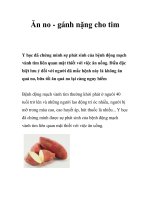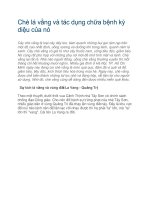neuro no audio
Bạn đang xem bản rút gọn của tài liệu. Xem và tải ngay bản đầy đủ của tài liệu tại đây (5.73 MB, 49 trang )
INTRODUCTION TO
NEURO MR
Dr. Francis Neuffer
USC School of Medicine
Department of Radiology
MR IMAGING
• Based on behavior of
protons exposed to a
magnetic field and a radio
wave
• T1, T2, FLAIR, Diffusion,
Gadolinium enhanced, and
Angiography are specific
types of Neuro imaging
sequences.
RF
MR INTERPRETATION
• Symmetry
• Identify normal structures
– Ventricles
– Grey matter structures
– White matter tracts
– Language – Intensity/ Signal
– Description of tissue signal on various different scanning
sequences ie.
– T1 T2 Flair Diffusion Gadolinium
MAGNETIC RESONANCE IMAGING
Limitations
1. ICU patients and Claustrophobia
2. Metal artifact
1. RF Energy – pacemaker override
2. Magnetic field - aneurysm clips - ocular metal
-missile effect
3. Nephrogenic Systemic Fibrosisgadolinium toxicity in renal failure
Child Dies in MRI Machine
The Associated Press
Monday, July 30, 2001: 2:42 p.m. EDT
A child undergoing an MRI exam received a
fatal head wound when the machine’s powerful
magnet pulled a metal oxygen canister inside.
GADOLINEUM TOXICITY
MAGNETIC RESONANCE IMAGING
Advantages
1. Multiple signal sources
2. No iodine toxicity/allergy issues
3. No ionizing radiation issues
MR HAS ADVANTAGE OF
MULTI PLANAR IMAGING
MRI INDICATIONS
•
•
•
•
•
Ischemia
Tumor
Infection
Dating blood products
Congenital abnormalities
MRI INTERPRETATION
• Pulse Sequences− T1 weighted-- (Fat, Melanin, Hemosiderin,
Methemoglobin= bright)
− T2 weighted-- (Water, Oxyhemoglobin, Hemosiderin=
bright)
− FLAIR-- (Pathology bright, CSF dark)
− Diffusion Weighted- recent infarction bright
MR SIGNAL
T1 SCAN
T2 SCAN
Tissues resonate a signal based on their intrinsic T2 time.
Tissues recover their magnetization based on intrinsic T1 time.
T1 SCAN
Anatomic structures
Fat = bright
Water = hypo intense
T2
SCAN
Water weighted sequence
Water = bright
Fat = relatively hypo intense
Good for identifying pathology
MRI FINDINGS OF ACUTE ISCHEMIC
STROKE
T1 (hypo intense)
T2 (hyper intense)
FLAIR (hyper intense)
FLAIR SCANS ARE T2 SCANS WITH THE FREE
WATER SIGNAL NULLED.
MRI FINDINGS OF ACUTE STROKE
T1 (hypo intense)
FLAIR (hyper intense)
T2 (hyper intense)
Diffusion (hyper intense)
DIFFUSION IMAGING
• DIFFUSION IMAGING SEPARATES INFARCTION
ON ACUTE OR CHRONIC BASIS
• THE ACUTE INFARCT HAS A DIFFERENT
DIFFUSION SIGNAL DUE TO INTRACELLULAR
EDEMA
DIFFUSION IMAGING
• Increased sensitivity for early changes of
edema
– Becomes abnormal within 30 mins.
– Ischemia Cellular Dysfunction
Increased
Intracellular Space
Restricted Diffusion of
Water Increased signal
• Distinguish b/w old and new stroke
• New stroke = bright on DWI (diffusion weighted image)
• Old stroke (encephalomalacia) = low SI on DWI
MRI ACUTE STROKE
T1
T2
PCA DISTRIBUTION
Diffusion
MRI
OLD -VS- NEW
ISCHEMIC INFARCT
T1
T2
DIFFUSION
ANATOMY
Temporal
lobe
Pons
4th ventricle
Middle
Cerebellar
peduncle
Occipital
lobe
Temporal
lobe
Pons
4th ventricle
Basillar
artery
ANATOMY
Supracellar
cistern
Aqueduct
Of Sylvius
Middle
Cerebral
artery
Cerebral
peduncle
Temporal
Horn lateral
venticle
Optic
chiasm
ANATOMY
ALIC
Middle
Cerebral
artery
PLIC
Corpus
callosum
Caudate
head
External
capsule
Thalamus
ALIC
Putamen
Globus
pallidus
PLIC
ANATOMY
Frontal
lobe
Middle
Cerebral
artery
Corona
radiata
Corpus
callosum
Lateral
ventricle
Parietal
lobe
Occipital
lobe
Anterior
Cerebral
artery









